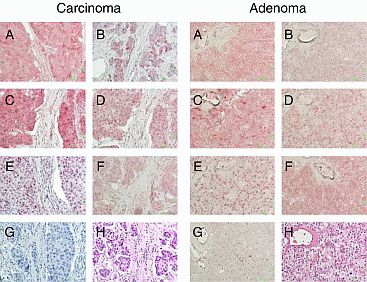ICEECE2012 Poster Presentations Adrenal cortex (113 abstracts)
The mTOR-pathway in normal and tumoral human adrenocortical tissues
M. De Martino 1, , P. van Koetsveld 1 , R. Feelders 1 , D. Sprij-Mooij 1 , M. Waaijers 1 , S. Lamberts 1 , W. de Herder 1 , A. Colao 2 , R. de Krijger 1 , R. Pivonello 2 & L. Hofland 1
1Erasmus MC, Rottedam, Netherlands; 2“Federico II” University, Naples, Italy.
Background: Novel treatment options are required for patients with adrenocortical carcinomas (ACCs). mTOR-inhibitors are anti-neoplastic drugs that target the mTOR-pathway.
Aim: To describe the expression of the mTOR-pathway in normal and pathological adrenocortical tissues.
Methods: We evaluated mRNA expression levels of mTOR, S6K and 4EBP1 in 10 normal adrenals (NA), 11 adrenal hyperplasias (AH), 19 adrenal adenomas (ACA) and 26 ACCs (24 adults, 2 children) by qRT-PCR and determined protein expression of total/phospho-mTOR; total-S6K/phospho-S6K and total/phospho-4EBP1 in 3 NAs, 3 AHs, 6 ACAs and 17 ACCs (15 adults, 2 children) by immunohistochemistry (IHC).
Results: The expression levels of mTOR and 4EBP-1 mRNA were not significantly different in the different tissues evaluated. The S6K mRNA levels were significantly lower in ACCs compared to the other groups (ACC: 0.10±0.08; ACA: 0.20±0.11; AH: 0.29±0.07; NA: 0.23±0.08; median±SD; P<0.01). In the NA and AH a stronger IHC staining of the evaluated proteins was observed in the glomerulosa and reticularis layers. The majority of ACCs and ACAs presented a significant IHC staining of total-mTOR (59%; 83%); total-4EBP1 (88%; 100%); phospho-4EBP1 (59%; 83%) and phospho-S6K (59%; 83%). A significant staining of phospho-mTOR and total-S6K were observed in 6% and 24% of ACCs and in 33% and 66% of ACAs, respectively.
Compressively a significant staining of both phospho-S6K and phospho-4EBP1 was observed in 41% ACCs and 84% ACAs. A significant expression of at least one of these proteins was observed in 13/17 ACCs (76%).
In ACCs, none of the evaluated mTOR-pathway components was correlated with the Weiss’s score or the hormonal status.
Conclusion: This study demonstrates a layer-specific expression of the major components of the mTOR-pathways in NA and the presence of an activated mTOR-pathway in the majority of adrenal tumors. These results support a potential role of mTOR-inhibitors in the treatment of selected patients with ACCs.
Immunocytochemical detection of total-mTOR (A), phospho-mTOR (B), total-4EBP1 (C), phospho-4EBP1 (D), total-S6K (E) and phospho-S6K (F) in a case of human adrenocortical carcinoma (ACC [left panel]) and a case of human adrenocortical adenoma (ACA [right panel]). Pictures “G” shows the absence of staining in the negative controls, and picture “H” the HE staining in both panels Magnification, X100.

Declaration of interest: The authors declare that there is no conflict of interest that could be perceived as prejudicing the impartiality of the research project.
Funding: This research did not receive any specific grant from any funding agency in the public, ommercial or not-for-profit sector.




